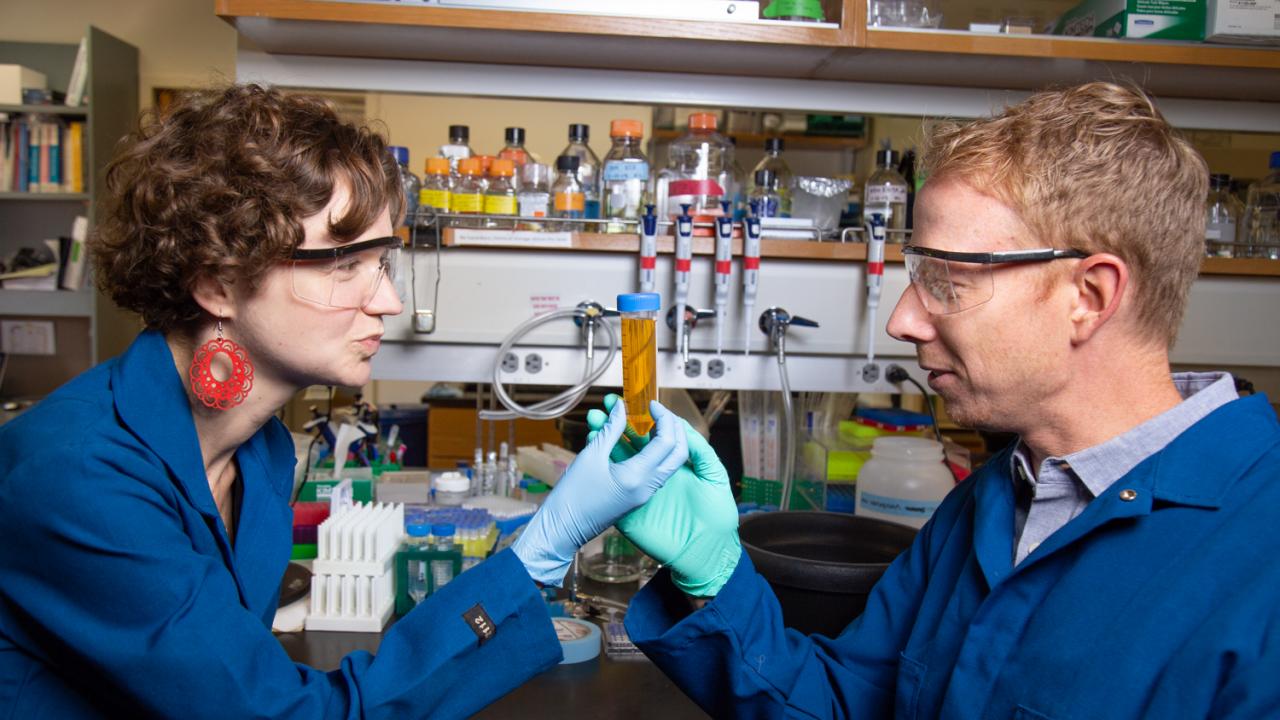
Perfect Chemistry: CBS Faculty Are Partners In and Outside the Lab
Quick Summary
- The MOM Lab at UC Davis hosts the research of biochemists Kassandra Ori-McKenney and Richard McKenney
- The husband and wife team met while working at Columbia University
- Their research concerns microtubules, the roadways of our cells, and how cellular proteins transport important biological materials via these roadways
After a long day of teaching and research, biochemists Richard McKenney and Kassandra Ori-McKenney usually find themselves on their patio discussing topics like the cytoskeleton and motor proteins. It’s shop talk for the couple, both assistant professors in the Department of Molecular and Cellular Biology.
“Our marriage is a nonstop lab meeting,” Richard said with a laugh.
At UC Davis, the husband and wife duo run their research labs, located in the Life Sciences Building. To their staff, it’s affectionately known as the MOM Lab. The path to this shared space at UC Davis started more than 10 years ago, when Richard’s and Kassandra’s relationship developed through a mutual love of science—and near obsession with cytoplasmic dynein, a protein responsible for transport within cells.

Love, it’s all in the brain
“We like to say we fell in love over cow brains,” said Kassandra, her eyes lighting up as she reflected on getting to know her husband.
In 2006, both Kassandra and Richard were starting their graduate projects on cytoplasmic dynein and the neuronal cytoskeleton at Columbia University. Before they could start their experiments, they first needed to dissect cow brains. This need led Kassandra and Richard to visit a New Jersey slaughterhouse at seven in the morning.
After renting a car and getting up before sunrise, Richard and Kassandra drove from Manhattan to Madison, New Jersey. Away from the lab, their conversations steered towards personal topics, like their childhood experiences and journeys to Columbia University. Kassandra said that moment was a turning point in their relationship.
It was “just the two of us from dawn ’til dusk,” said Kassandra.
After that, the two spent as much time as they could together. They pushed each other in the lab, running experiments together and constantly working long, late hours.
“It was an intense period of emotion and science. Sort of a melding of the two,” recalled Richard.
At Columbia, on the fifteenth floor at 168th and Broadway, Richard and Kassandra spent their graduate years back-to-back at the workbench. They found being together in such close quarters strengthened their science.
With graduation around the corner, the pair knew they wanted to continue in academic science. Determined, they found two post-doc positions at UC San Francisco and moved from the East Coast to California.
“We were in buildings that were right next to each other and we met up every day for lunch,” said Richard. “We basically didn't want to be apart.”

Sharing lab space and knowledge
The two-body problem is a common issue academic couples face when seeking university employment. Kassandra and Richard confronted this head-on by applying to jobs all over the country. After sending in 80 job applications, they each got six individual interviews. But they were also offered six joint interviews, including one with UC Davis.
UC Davis extended an appealing offer for Kassandra and Richard to become junior faculty, share a connected lab space to fuel their passions and integrate ideas and about science. With the added bonus of world-class departmental colleagues in their fields of interest, the couple was sold.
After arriving in January 2016, they got to work setting up their space, recruiting students and designing experiments. Taking notes from Kassandra’s postdoctoral mentor, Yuh Nung Jan, they modeled their new labs on UCSF’s jointly run Jan Lab, helmed by the well-known and dynamic couple Lily and Yuh Nung. Both successful scientists, the Jans’ relationship inspired Kassandra and Richard. The McKenney Ori-McKenney Lab was born, complete with a memorable acronym.
Today, the MOM Lab employs a principle of openness. Lab meetings, equipment and ideas are shared in the space, and the students working within it have the unique experience of utilizing both Kassandra and Richard for help, guidance and advice.

“While we each now have our own individual research interests, progressing through the ranks of graduate school and postdoc together has put us largely on the same page for many day-to-day lab issues that arise,” said Richard. “I give my opinions to Kassandra’s students, she gives her opinions to my students. We read each other’s grants and papers that are going out. I think it’s very much an integrated space.”
“And we can be completely, bluntly honest with one another and tell each other when data isn’t convincing or if a protein looks awful.” Kassandra added. “We both feel that being open and honest is the only way to continually progress—in both science and marriage.”
